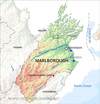32 - New Zealand Flashcards
Outline the situation and climate of New Zealand. (6)
Remote and maritime with cooling effect from Pacific Ocean and Tasman Sea
Temps vary due to latitude differences 36-46S –> cool - moderate w/ North Island warmer
Southern Alps protect vineyards from wind and rain –> most vineyards planted on eastern side
Rainfall high ~650mm
Sunlight intense due to latitude, hole in ozone, lack of air pollution –> >2000hrs of sunshine per year
High diurnal range due
Outline how high sunshine levels influence grape growing. (3)
More southerly sites are viable for growing due to extended daylight hours
Enhances development of colour + tannin
Possibility of sunburn
Why is proper canopy management so important in NZ? What kind is usually practised?
- Damp climate, fertile soils, plentiful sunlight –> vigour and disease pressure
- Sunburn from >2000hrs of sunshine
Vines are trained and pruned for large number of buds per vine –> double-Guyot, Lyre, Scott-Henry
Therefore vines have high yield 70 hL/ha despite low planting density 2000 VPH
Vines are usually VSP’d
To what extent is mechanisation practised?
Widely practised due to flat land.
In general, describe the soils of NZ.
Fertile but often free-draining esp. alluvial
Outline the viticultural challenges in NZ (6)
- Managing vigour –> trellising systems
- Fungal disease esp. on warmer North Island
- Birds - eat grapes, damaged fruit gets infected –> netting, scarers
- Sunburn –> leaf position, trellising
- Tropical cyclones –> flowering and fruit set
- Drought - due to free-draining soil –> irrigate, plant wind breaks
To what extent have sustainable growing practices been adopted in New Zealand?
Almost all producers part of Sustainable Winegrowing NZ
But <5% organic - wet, humid conditions
Some regions like Central Otago have much higher ~17%
Describe the characteristics of Sauvignon Blanc.
Late budding / early ripening
Vigorous
Vulnerable to: powdery mildew, BBR, Esca, Eutypa
Gooseberry, grapefruit, wet stone, passionfruit
High acid, med alcohol, medium body
Describe the factors and decisions in the vineyard (5) and the winery (7) to produce the typical Marlborough Sauvignon Blanc.
Aim is produce a wine with intense aromatic flavours
Vineyard
Diurnals ensure long growing season –> intensity and acidity
Row orientation –> sunny side gives tropical, shady side gives herbaceous
Canopy management –> ensure adequate sunlight interception w/o sunburn
Early picking of % –> herbaceous, acidity
Mehanical harvesting –> some skin contact during transportation
Winery
Refrigerate fruit to reduce contact w/ oxygen –> primary fruit
Selected yeasts –> enhance aromatics
Low fermentation temp –> retain primary
Block malo –> preserve acid, primary fruit
Minimal ageing (2-3mnths) –> primary fruit
Age on lees –> primary fruit
Ascrbic acid and SO2 at bottling + screwcap –> primary fruit
Producers of Sauvignon Blanc seeking to produce a more complex, age-worthy style may do what? (7)
Use riper fruit –> less herbaceous character
Skin contact on % of fruit ~2mnths –> texture and aromas
High % of solids in ferment –> texture and non-fruit complexity
Ambient yeasts –> flavour complexity
Barrel fermentation/maturation –> non-fruit complexity, oak flavours
Partial or full-malo –> texture, non fruit complexity
Lees stirring –> texture, non fruit complexity
Describe the typical approach to vinification for red wines. (4)
High vol - mid-range temps, cultured yeast, neutral vessels
Wholebunch experimentation for PN and Syrah –> herbal, floral
Cold maceration common for PN
Maturation in oak barriques for BDX while larger oak for PN
Which wines may be made in various levels of sweetness?
Pinot Gris and Riesling with noble-rot affected Semillon also produced
To what extent are screw caps used and why?
What challenges does it present for marketing wine?
90% using screw cap including many premium wines to reduce risk of TCA, premox and bottle variation
Consumer acceptance of screw cap good domestically and in some regions like UK but less so in others
Describe the growing environment of the North Island including details of some of its sub-regions.
Moderate, maritime climate with high humidity
Diurnals vary depending on the exact location e.g. Waiheke Island has low diurnals as it is surrounded by water, Martinborough has high diurnals as it is more sheltered
Undulating landscape means some vineyards more sheltered e.g. Martinborough
High rainfall up to 1000mm per year

Briefly describe any notable features and the wines produced in Auckland
Land is expensive due to urbanisation.
Waiheke Island specialises in Cabernet Sauvignon and Syrah due to moderate climate, low diurnals –> med-full bodied, black fruit, oak, premium.
West Auckland home to HQ Chardonnay made by Kumeau River.








